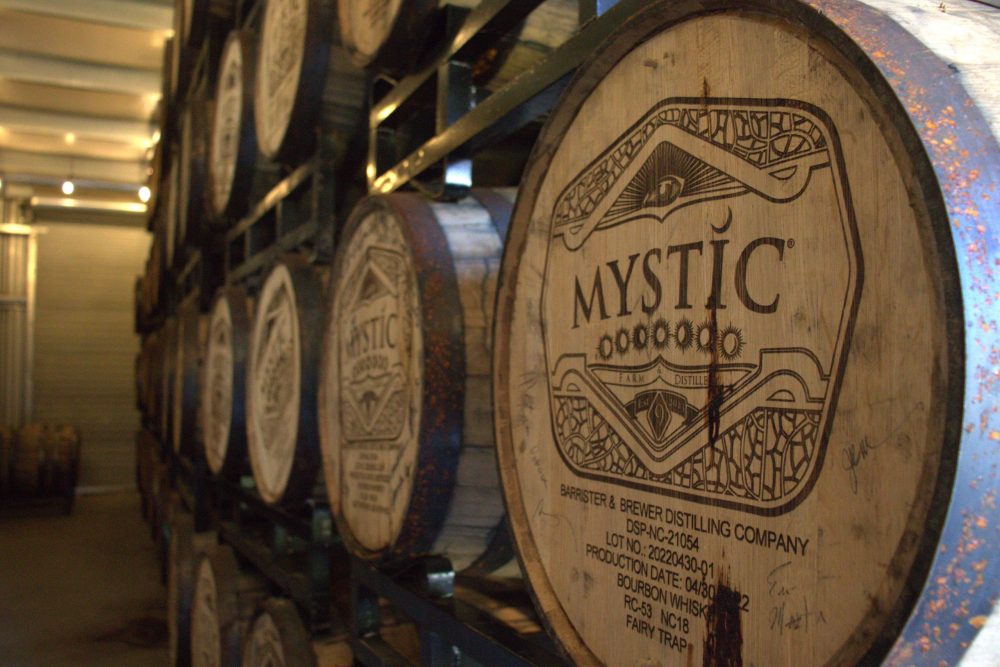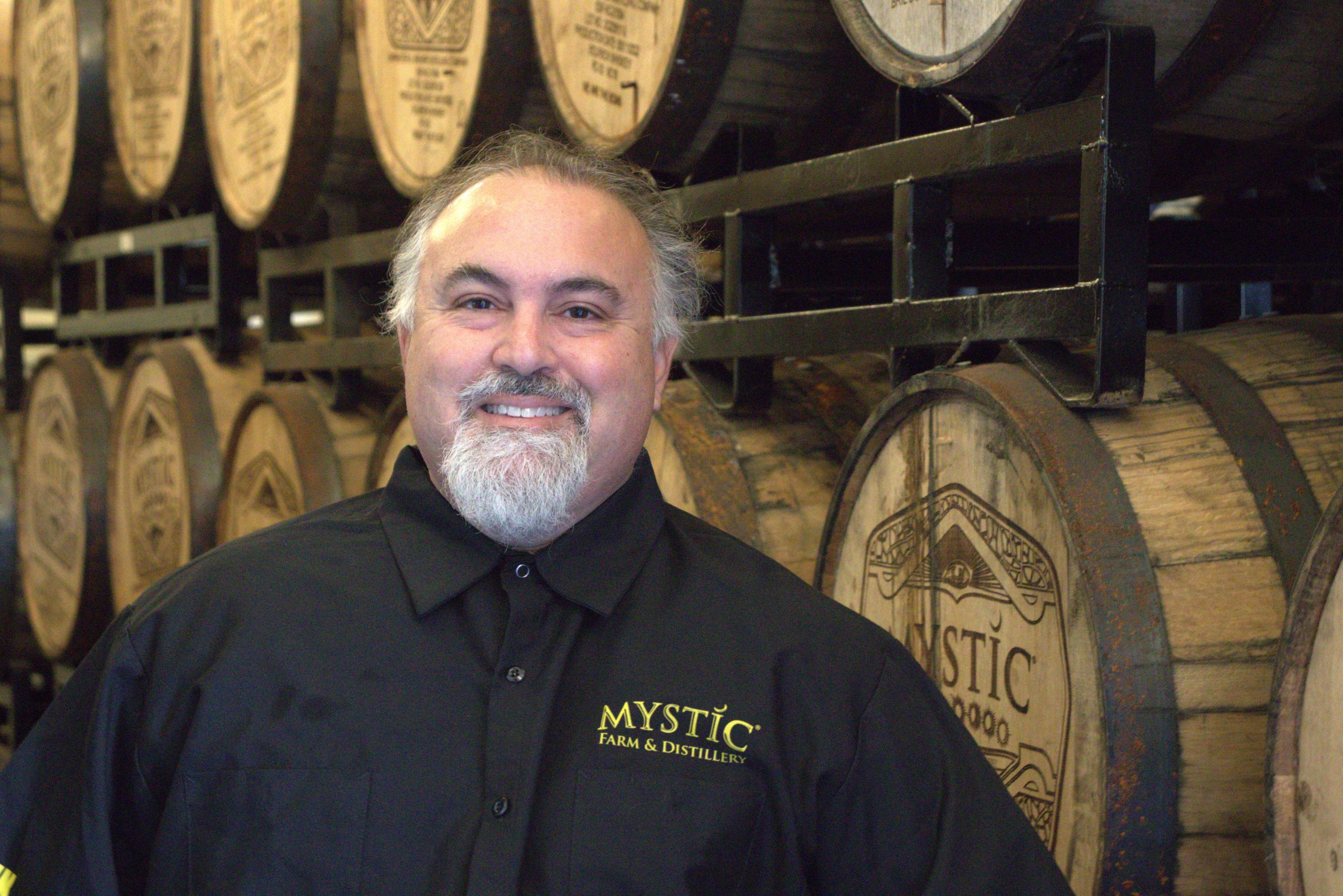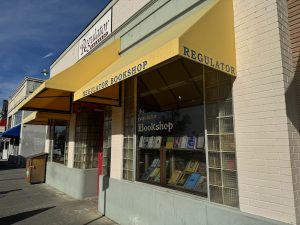In January 2026, Jonathan Blitz, owner of a Durham distillery, will arrive at the Kennedy Space Station. He’ll have been looking forward to this day for years. As he watches the spaceship prepare for takeoff, he’ll know that a multi-million investment teeters precariously atop one SpaceX Falcon Heavy rocket. He’ll take a deep breath, close his eyes, and count.
3….2…1…
And off it’ll go. Blitz, the co-owner of Durham’s Mystic Farm and Distillery, will have launched ten barrels of bourbon into low-Earth orbit, a region of outer space less than 1,200 miles above the Earth’s surface.
At least that’s the plan.
***
His golden bourbon had already won international awards, earning the title of “one of the finest spirits in the world.” So last year, Blitz decided to aim much higher.
He and his business partner, Michael Sinclair, were speeding down the highway en route to one of their weekly tasting trips, discussing creative ways to age bourbon.
Some companies were aging bourbon on boats. Others were ascending to mountaintops.
“That’s amateur. Let’s go to space,” said Blitz.
Blitz has always been captivated by the cosmos. Born in 1972, the last year that any American astronaut walked on the moon, he grew up on the tail end of America’s glory days in space.
Throughout his childhood, Blitz heard rumors that soon, cutting-edge products would be manufactured in outer space. But other than a couple of crystals crafted in spaceships, he said these promises hung in the cosmos unfulfilled.
He decided to take matters into his own hands. Mystic Distillery is now working with the Space Exploration company (SpaceX) and Inversion Space to make his dream a reality.
Mystic Galactic Bourbon will age in barrels for three years on the ground before it is launched on an unmanned expedition to space. The spaceship, solely dedicated to carrying Mystic bourbon, will orbit the Earth for 365 days. Once the barrels return from their year-long space odyssey, 1,000 people who pre-ordered bottles for $75,000 a piece will have the chance to taste this luxury extra-terrestrial concoction, delivered in an aluminum case.
Launching a spaceship that will survive re-entry into the Earth’s atmosphere is no easy feat, Blitz says. He never anticipated charging $75,000 a bottle. But that changed as he did his research. “It rapidly became clear that you can get it to space for $15,000 a bottle, but you’ll never get it back.”
In order for this privately funded mission to launch as planned, Mystic will have to sell 1,000 bottles before takeoff. While none have been sold yet, Blitz says he is “very certain” they can reach the target. If the mission goes south, customers will receive a full refund, he added.
Buying a bottle of Mystic Galactic is about more than just the product, Blitz says. Customers will receive access to a live video stream from inside the spaceship. And when the barrels are zooming overhead, the purchasers will receive notifications “telling them where to look in the sky” (for this price, let’s hope for clear skies). Buyers also will be invited to two celebratory events, one at the launch site and another at the recovery site in the Atlantic Ocean, off of the Eastern Seaboard.
Blitz also hopes to conduct experiments in space, allowing students nationwide to tune in directly and play with virtual interactive activities inside the unpressurized service module.
If this all seems a bit, well, out there, it is. Some might call it frivolous or even debauched. But practicality isn’t the point, Blitz says.
“You don’t buy a Ferrari to drive to the grocery store. You buy a Ferrari because you want to have it,” he says. “This is the same idea. You’re buying it to experience something very few people will ever get to experience.”
Other alcohol brands like Ardbeg and Petrus have conducted experiments aging whiskey and wine (respectively) in space. Petrus put a bottle of space-aged French wine up for sale in May 2021 for an estimated $1 million, which wine critic and author Jane Anson had the opportunity to sample.
“The wine tasted a little more evolved than the example of the same wine that had remained on earth,” she said. “More tertiary character of truffle and rose.”
Anson believes there is a market for space-aged alcohol. “It can be seen as a gimmick, and certainly one that is extremely expensive to put into practice, but the team behind Petrus in space found huge interest from the public in what they had done,” she said. “I imagine the same will be true for bourbon.”
Blitz echoed this sentiment, saying he anticipates that bourbon enthusiasts who collect, trade, and sell bottles will line up to lay their lips on a glass of space bourbon.
Mystic plans to send the bourbon into space for an entire year to ensure that it receives enough solar radiation to affect its taste and aging profile, he said. With volatile temperatures in low-Earth orbit ranging from -85 to 257 degrees Fahrenheit, the bourbon will likely taste “different than terrestrial whiskey, ” he said. But exactly how, Blitz doesn’t know.
“People keep asking what it’s gonna taste like, but nobody knows,” he said. That’s the multi-million dollar question.
***
Although Blitz, 50, has now dedicated his life to bourbon, it wasn’t always the plan. His wife cheekily calls his career “a hobby that got completely out of hand.”
Blitz is a St. Louis native who dabbled in various fields, from production pottery to law to solar energy, before discovering his love of bourbon.
Love and marriage brought him to Durham after he met his now-wife, who was pursuing her Ph.D. at Duke University. Blitz practiced law until his son was born in 2010 and he became a full-time dad.
A few years later, he and his friend Michael Sinclair, who had worked at Red Oak Brewery, began to discuss opening a large distillery together.
“We made all these business plans and slide decks and we had a pitch,” he said with a laugh. “But then nobody wanted to give us any money.”
One day, after their “probably 30th investor meeting,” Sinclair handed Blitz a mason jar. “‘I want you to taste something,’” Blitz says Sinclair said.
Blitz wasn’t a big drinker, but the liquor Sinclair handed him was unlike anything he’d ever tasted — sweet, easy to drink, “just perfect.” Turning to Sinclair, Blitz said the world didn’t need another large manufacturer, it “just needed this.”
They leased a small distillery in downtown Durham, financing it with their credit cards, and got down to distilling. They soon discovered that locals were thirsty for locally produced liquor and expanded into South Carolina and Virginia as they outgrew their original facility.
At its current site, Mystic Distillery has a rickhouse for aging and storing bourbon, an expansive events space and a picturesque pond with delicate string lights suspended above.
Sourcing water directly from the aquifer, Mystic grinds all of its own corn and grain and pumps it into a mash on site. The alcohol is then extracted from the grain through distillation, a process that involves boiling the mixture, capturing the resulting vapor, and recondensing it into a high-proof liquor. Distilling pots and columns line the walls of the distillery, and the sweet smell of the bubbly brew wafts through the facility.
“We’re never going to make wine like Napa because we don’t have the climate for it,” Blitz said. “But we can make the best bourbon in the world. We’re living proof of that.”
Mystic is a unique community center as well, attracting hundreds of visitors each month for line dancing classes, tasting and blending workshops and art markets. One popular offering is the “single barrel experience,” where guests spend a day crafting their own barrel of bourbon and return annually to sample the maturing spirit.
Blitz says Mystic also has a positive impact on North Carolina’s economy. The bourbon process transforms “six-bucks-a-bushel” corn into premium liquor that can sell for $150 or more per bottle and that is taxed at 30%, he notes.
“Look at what Kentucky’s done,” he said. “If they didn’t have distilling, they’d be coal mining and growing pot.”
Then he paused a moment. “Well, I guess they got the whole horse-racing thing, too.”
***
“When people ask me, ‘Why don’t you automate this part of the process? Why don’t you scale up this part?’ The answer is, ‘We’re not Ford. We’re not even Audi. We’re Bugatti,’” Blitz said. “We’re under no pressure to put out anything except the best possible product.”
The attention to detail seems to pay off. After winning consecutive gold medals in 2021 and 2022 at the San Francisco World Spirits Competition, Mystic won a double-gold medal in April of this year.
International recognition notwithstanding, Blitz hopes the Mystic Galactic mission will be what really puts “North Carolina bourbon on the map.”
Some sneer at a small distillery embarking on a momentous space odyssey, Blitz says. Steve Akley and Jeremy Schell, hosts of the bourbon podcast “The Bourbon Show” questioned Mystic Galactic’s price tag, asking, “Why the hell would [anyone] want this?”
But Blitz believes that only a small distillery could manage a project this risky. And he hopes that most will be impressed that his “little distillery has the gumption and guts to do it,” he said. “It’s an interesting case study in the environment you need for innovation.” Blitz thinks it’s hard to maintain a high-quality product at a huge industrial scale. In fact, Mystic recently scaled back its business, shutting down its South Carolina and Virginia operations to focus on the quality of its production in North Carolina.
***
Blitz hopes to keep Mystic’s innovative spirit alive for years to come. He’d be thrilled to hand off the business to his 10-year-old son one day. That is, if his son turns out to be as passionate about bourbon as he and his team are.
In addition to its paid staff, Mystic relies on bottling crews made up of volunteers who are compensated only with cocktails and lunch. They continue to show up and work because they are genuinely passionate about the process, he said.
“It’s wonderful,” he continued. “I think creating something like this is magical.”
And soon, it’ll also be “other-worldly.”
Above: Photo of Jonathan Blitz by Maddie Wray — The 9th Street Journal









